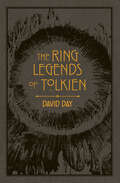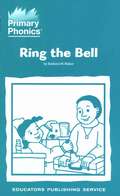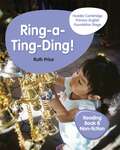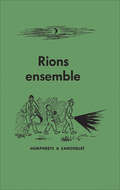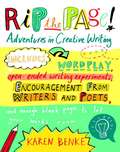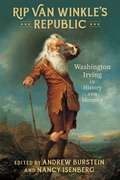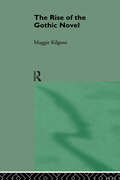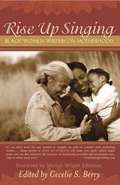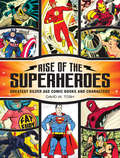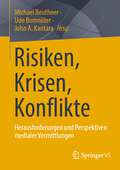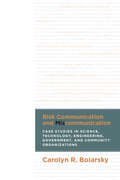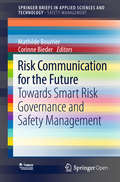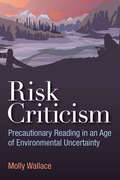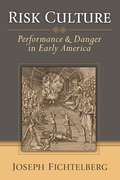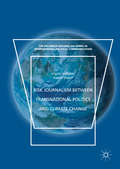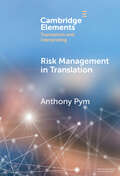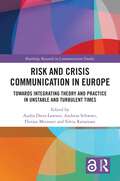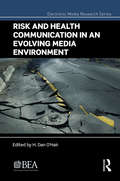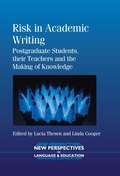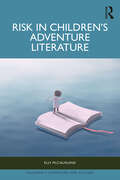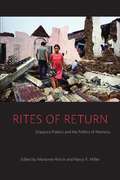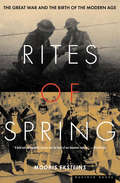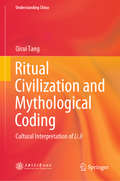- Table View
- List View
Rimjhim class 4 - NCERT - 23: रिमझिम ४थीं कक्षा - एनसीईआरटी - २३
by Rashtriy Shaikshik Anusandhan Aur Prashikshan Parishadराष्ट्रीय पाठ्यचर्या की रूपरेखा-2005 सभी मूल्यों की जड़ में सामाजिक सद्भाव एवं शांति को चिह्नित करती है और इस उद्देश्य के लिए प्रत्येक विषय को महत्त्व देती है। शांतिपरक मूल्यों के विकास में भाषा की भूमिका सर्वाधिक महत्त्वपूर्ण है। भाषा किसी भी संस्कृति में मूल्यों को बनाए रखने का काम करती है। दूसरों के प्रति खासकर असमानता, क्षमता या पृष्ठभूमि के अंतर के संदर्भ में बच्चों को संवेदनशील बनाना भी भाषा-शिक्षण के दौरान होना चाहिए। इसी बात को ध्यान में रखते हुए पुस्तक में सुनीता की पहिया कुर्सी पाठ दिया गया है। इसी तरह की अन्य सामग्री पत्र-पत्रिकाओं से या स्वयं विकसित करके शिक्षक उनका उपयोग कर सकते हैं। शिक्षक को चाहिए कि मूल्यों के विकास में भाषा की भूमिका सुनिश्चित करते हुए कक्षा में अपने और बच्चों के व्यवहार में उसकी परिणति लाए। रिमझिम 4 में भी कई पाठ सिर्फ़ पढ़ने के लिए दिए गए हैं उनके साथ कोई प्रश्न नहीं है। इन पाठों को देने का उद्देश्य बच्चों को पढ़ने की अतिरिक्त सामग्री उपलब्ध कराना है जिसे वे प्रश्नों के बोझ से मुक्त होकर आनंद लेते हुए पढ़ सकें। बच्चों को पढ़ने के जितने अधिक अवसर मिलेंगे, उतना ही अधिक उनकी पढ़ने की गति एवं शब्द-भंडार बढ़ेगा तथा वर्तनी संबंधी त्रुटियों में कमी आएगी।
Rimjhim class 5 - NCERT - 23: रिमझिम ५वीं कक्षा - एनसीईआरटी - २३
by Rashtriy Shaikshik Anusandhan Aur Prashikshan Parishadइस रिमझिम पुस्तक में ताने-बाने को चार सूत्रों में पिरोया गया है। हर सूत्र का अपना रंग और अपनी छटा है। अपनी-अपनी रंगतें के अंतर्गत रीति-रिवाज़, जीवन शैली, हुनर, विरासत और बोली आदि संस्कृति के विभिन्न आयामों की झलक है। इस भाग को पढ़ाते समय यह ध्यान में रखना ज़रूरी होगा कि सांस्कृतिक विविधता के बारे में शिक्षक का स्वयं का ज्ञान ही इन पाठों को बच्चे के लिए जीवंत बना सकता है। इस भाग के माध्यम से रिमझिम-5 हमारी अनमोल विरासत को सहेजने का प्रयास है। अभिव्यक्ति के कई माध्यम हैं। समय के साथ-साथ इन माध्यमों में भी बदलाव आया है। अपनी बात लोगों तक पहुँचाने का तरीका समय के साथ कैसे बदलता रहा है- पुस्तक के दूसरे भाग बात का सफ़र में इसी रोचक सफ़र की झलक है। रिमझिम-5 में कई साहित्यकारों की रचनाएँ ली गई हैं। जैसे- प्रेमचंद, सुभद्रा कुमारी चौहान, नागार्जुन, सोहनलाल द्विवेदी, आर. के. नारायण आदि। आने वाली कक्षाओं में साहित्य से बच्चों का परिचय उत्तरोत्तर बढ़ता जाएगा। रचनाओं को गहराई से समझने के लिए उनके लेखकों का परिचय उपयोगी है।
Ring Legends of Tolkien (Tolkien Illustrated Guides #7)
by David DayLearn the most popular legends about the Rings of Power!The history of J. R. R. Tolkien's fictional world of Middle-earth is filled with an ongoing struggle between good and evil, centered on a set of rings forged by Elves and an evil sorcerer. The Ring Legends of Tolkien recounts stories and conflicts surrounding the Rings of Power. Insightful commentary by Tolkien scholar David Day discusses how people, tactics, and weapons were used to obtain and control the rings, and also how the legends of Middle-earth relate to the real-world mythology on which Tolkien based his famous literary creation. Maps and full-color illustrations help bring this rich universe to life, making it an invaluable reference book for Tolkien fans of all ages. This work is unofficial and is not authorized by the Tolkien Estate or HarperCollins Publishers.
Ring-a-Ting-Ding!
by Ruth PriceExplore, support and consolidate communication and language and literacy skills with a colourful non-fiction book for ages 4-5, containing key concepts and practice opportunities. Practise key communication, language and literacy skills and concepts with simple question prompts on each page and activities at the end of the book. Support the themes covered in Activity Book B and the Teacher’s Pack. Ring-a-Ting-Ding! Which instruments can we ring, shake and bang? Books in the Hodder Cambridge Primary English series for the Foundation Stage: Activity Book A – 9781510457249 Activity Book B – 9781510457256 Activity Book C – 9781510457263 Reading Book A FICTION No Nap for Grandad – 9781510457270 Reading Book B FICTION The Floating Market – 9781510457294 Reading Book C FICTION How Zebra got his Coat – 9781510457300 Reading Book A NON-FICTION Outside Play – 9781510457287 Reading Book B NON-FICTION Ring-a-Ting-Ding! – 9781510457331 Reading Book C NON-FICTION Let’s Pretend – 9781510457348 Teacher’s Pack – 9781510457379 HODDER EDUCATION e: education@bookpoint.co.uk w: hoddereducation.com
Rions ensemble
by Harold Humphreys Michel SanouilletThe twenty-five crisp and amusing short stories in this collection prove that elementary readings in French can also be entertaining. Some are original anecdotes and others adaptations of traditional French of French-Canadian stories, some are from anonymous sources, and some by acknowledged masters such as LaFontaine. All are distinguished by the classic literary virtue of the French—precision, economy, and the traditional Gallic twist. A delightful series of line drawings by Antje Lingner aptly reflects the spirit of the book. This collection is designed for reading in Grades XI and XII, and for introductory courses at the University or Extension course level. To encourage a quick response and facility in reading, the stories emphasize the idiomatic and rely heavily on dialogue, avoiding as much as possible an over-literary syntax. The text employs elementary vocabulary and constructions throughout and is representative in all respects of the spoken language today. The emphasis on conversational organization in the stories will be immediately apparent, and it is this feature that should be exploited in the classroom and other group situations. On a series of four long-playing records the entire text has been transcribed for use in oral and phonetics classes. The readings are given slowly but naturally and with a relish which catches the drama and humour of the material. The combination of text and recordings offers a most valuable method of acquiring aural familiarity with spoken French. The stories are supplemented with vocabulary, notes and exercises. For each story there is supplied a series of questions that lend themselves to oral answers and discussion; in addition there is a short exercise reviewing grammatical forms, with special emphasis on the verb, as well as a brief passage for prose translation into French.
Rip The Page: Adventures in Creative Writing
by Karen BenkeBenke, who has led writing workshops for 16 years as part of the California Poets in the Schools program, offers teachers a wealth of ideas to make writing fun and exciting, offering quotes from writers and poets, lists of words, suggestions, and experiments, such as various exercises in non-written artistic expression of emotion. Useful for kids who wish to try creative writing, as well as parents and teachers of children's writing classes.
Rip Van Winkle’s Republic: Washington Irving in History and Memory
by Andrew Burstein and Nancy IsenbergTwo centuries ago, native New Yorker Washington Irving exploded onto the literary scene of Europe with the publication of his breakout collection of stories, The Sketch Book of Geoffrey Crayon, Gent. Published in England and America in 1819–1820, and universally praised for its inventive characters and soul-searching qualities, including the immortal tales “Rip Van Winkle” and “The Legend of Sleepy Hollow,” the volume enjoyed remarkable transatlantic success, allowing Irving to become the first of his nation to support himself as a professional author.In this distinctive collection, historians and literary scholars come together to reassess Irving’s imaginative world and complex cultural legacy. Alternately a satirist and a nostalgia merchant, Irving was ever absorbed in reconstituting a lost past, which the volume dubs “Rip Van Winkle’s Republic.” The assembled scholars explore issues of Anglo-American culture, the power of imagery, race, and the treatment of time and history in Irving’s vast body of literature, as well as his status as a bibliophile, an antiquarian, and a prominent figure in an age of literary celebrity. Edited by acclaimed historians Andrew Burstein and Nancy Isenberg, Rip Van Winkle’s Republic marks a rediscovery of this marvelous author of social satire and fabled tales of the past.
Rise Of Gothic Novel
by Maggie KilgourOne of the central images conjured up by the gothic novel is that of a shadowy spectre slowly rising from a mysterious abyss. In The Rise of the Gothic Novel, Maggie Kilgour argues that the ghost of the gothic is now resurrected in the critical methodologies which investigate it for the revelation of buried cultural secrets. In this cogent analysis of the rise and fall of the gothic as a popular form, Kilgour juxtaposes the writings of William Godwin with Mary Wollstonecraft, and Ann Radcliffe with Matthew Lewis. She concludes with a close reading of the quintessential gothic novel, Mary Shelley's Frankenstein. An impressive and highly original study, The Rise of the Gothic Novel is an invaluable contribution to the continuing literary debates which surround this influential genre.
Rise Up Singing
by Cecelie BerryFrom a dazzling array of well-known African American women, short fiction, poems, and personal essays that describe with warmth and humor their experiences as mothers and as daughters. A sparkling anthology devoted to exploring the lives of African American mothers, Rise Up Singing presents the stories and reflections of such beloved and respected artists, journalists, and authors as Alice Walker, Faith Ringgold, Marita Golden, Martha Southgate, Tananarive Due, Maya Angelou, Gwendolyn Brooks, Deborah Roberts, Rita Dove, and others. It features original and previously published writings, organized by editor Cecelie Berry by themes--mothering, work, family, children, community, and love--that illuminate the multiple roles of black mothers at home, in the neighborhood, and in the world as a whole. Rise Up Singing brings together the perspectives of women of different ages, backgrounds, and accomplishments. What shines through in their writings are the hopes shared by all mothers. As Marian Wright Edelman writes in the Foreword: "The mothers writing in this anthology speak in a range of voices. They are joyful, stressed, grateful, ambivalent, determined, disappointed, and, in bad ways and good, overwhelmed. But over and over again ... we see mothers struggling with the push: striving to give their children their best and to make sure the world gives their children its best, hard as that fight may be."
Rise of the Superheroes: Greatest Silver Age Comic Books and Characters
by David ToshThey Could Be HeroesRise of the Superheroes--Greatest Silver Age Comic Books and Characters is a visual and entertaining adventure exploring one of the most popular and significant eras of comic book history. From 1956 to 1970, the era gave us Spider-Man, The Avengers, X-Men, The Incredible Hulk, Iron Man and a flurry of other unforgettable and formidable characters. The Silver Age redefined and immortalized superheroes as the massive pop culture titans they are today. Lavishly illustrated with comic book covers and original art, the book chronicles:The new frontier of DC Comics, with a revamped Batman, Superman and Wonder Woman, and new characters including HawkmanMarvel's new comics featuring Thor and The Fantastic FourThe pop art years that saw Batman's "new look" and the TV seriesIndependent characters, including Fat Fury and T.H.U.N.D.E.R. AgentsSpotlights new and re-imagined superheroes, like Wonder Woman, who have become central to modern pop cultureIncludes values of these comics, which are popular with collectorsThanks to the Silver Age, superheroes are bigger and badder than ever.
Risiken, Krisen, Konflikte: Herausforderungen und Perspektiven medialer Vermittlungen
by Michael Beuthner Udo Bomnüter John A. KantaraCorona-Pandemie, Klimawandel, Terrorismus, Flüchtlings- und Wirtschaftskrise, Militäreinsätze in Afghanistan und Mali, Abgasskandal etc. Die Liste der Risiken, Krisen und Konflikte ist lang, und die „Fälle“ sind zunehmend komplex. Wie steht es um die professionelle Kommunikation darüber? Ist sie hinreichend transparent und achtsam-kritisch, oder vielmehr interessengeleitet und oberflächlich? Interne Strukturen und Vorgaben sowie dynamische externe Rahmenbedingungen erschweren die Kommunikation. Es mangelt mitunter an Formaten, Möglichkeiten, Ressourcen, Mut oder auch Expertise und Können. Diejenigen, die bei Risiken und Krisen professionell Öffentlichkeit herstellen (müssen), kommunizieren möglicherweise nicht ausreichend (gut) miteinander und haben dabei die Optionen sozialer Medien und deren Akteure (noch) nicht regelmäßig im Blickfeld. Das vielschichtige Beziehungsgeflecht der Kommunikatoren bietet scheinbar mehr Irritations- als Synergiepotentiale.Der Sammelband bündelt erstmalig in dieser Form interdisziplinäre Erfahrungswerte und Erkenntnisse von Akteuren aus Journalismus, Politik, Wissenschaft, Umwelt und Gesundheit. Dadurch werden Herausforderungen und Chancen medialer Vermittlung von Risiken und Krisen identifiziert und zugleich die Notwendigkeit und Ansatzpunkte für eine explizit auf dieses Thema ausgerichtete Ausbildung verdeutlicht.
Risk Communication and Miscommunication: Case Studies in Science, Technology, Engineering, Government, and Community Organizations
by Carolyn BoiarskyEffective communication can help prevent or minimize damage from environmental disasters. In Risk Communication and Miscommunication, Carolyn Boiarsky teaches students, technical writers, public affairs officers, engineers, scientists, and governmental officials the writing and communication skills necessary for dealing with environmental and technological problems that could lead to major crises. Drawing from research in rhetoric, linguistics, technical communication, educational psychology, and web design, Boiarsky provides a new way to look at risk communication. She shows how failing to consider the readers’ needs and the rhetorical context in which a document is read can be catastrophic and how anticipating those needs can enhance effectiveness and prevent disaster. She examines the communications and miscommunications of original e-mails, memos, and presentations about various environmental disasters, including the Columbia space shuttle breakup and the BP/Deepwater Horizon oil rig explosion, and successes, such as the Enbridge pipeline expansion and the opening of the Mississippi Spillway, offering recommendations for effective communication. Taking into account the growing need to communicate complex and often controversial issues across vast geographic and cultural spaces with an ever-expanding array of electronic media, Risk Communication and Miscommunication provides strategies for clear communication of data, ideas, and procedures to varied audiences to prevent or minimize damage from environmental incidents.
Risk Communication for the Future: Towards Smart Risk Governance and Safety Management (SpringerBriefs in Applied Sciences and Technology)
by Mathilde Bourrier Corinne BiederThe conventional approach to risk communication, based on a centralized and controlled model, has led to blatant failures in the management of recent safety related events. In parallel, several cases have proved that actors not thought of as risk governance or safety management contributors may play a positive role regarding safety. Building on these two observations and bridging the gap between risk communication and safety practices leads to a new, more societal perspective on risk communication, that allows for smart risk governance and safety management. This book is Open Access under a CC-BY licence.
Risk Criticism: Precautionary Reading in an Age of Environmental Uncertainty
by Molly WallaceRisk Criticism is a study of literary and cultural responses to global environmental risk in an age of unfolding ecological catastrophe. In 2015, the Bulletin of the Atomic Scientists reset its iconic Doomsday Clock to three minutes to midnight, as close to the apocalypse as it has been since 1953. What pushed its hands was not just the threat of nuclear weapons, but also other global environmental risks that the Bulletin judged to have risen to the scale of the nuclear, including climate change and innovations in the life sciences. If we may once have believed that the end of days would come in a blaze of nuclear firestorm, we now suspect that the apocalypse may be much slower, creeping in as chemical toxins, climate change, or nano-technologies run amok. Taking inspiration from the questions raised by the Bulletin's synecdochical "nuclear," Risk Criticism aims to generate a hybrid form of critical practice that brings "nuclear criticism" into conversation with ecocriticism. Through readings of novels, films, theater, poetry, visual art, websites, news reports, and essays, Risk Criticism tracks the diverse ways in which environmental risks are understood and represented today.
Risk Culture
by Joseph Fichtelberg"As a number of recent studies have shown, the north European commercial world made the precise calculation of risk a central concern of the intellectual project of exploration, trade, and colonization. The great merit of Fichtelberg's book is systematizing the imaged world of dangers, and charting the various kinds of ritual and discursive performances marshaled to deal with the pressure of the unspeakable in early America from the 17th into the early 19th century. The readings of texts are invariably careful, and the points made, persuasive. " ---David Shields, University of South Carolina Risk Cultureis the first scholarly book to explore how strategies of performance shaped American responses to modernity. By examining a variety of early American authors and cultural figures, from John Smith and the Salem witches to Phillis Wheatley, Susanna Rowson, and Aaron Burr, Joseph Fichtelberg shows how early Americans created and resisted a dangerously liberating new world. The texts surveyed confront change through a variety of performances designed both to imagine and deter menaces ranging from Smith's hostile Indians, to Wheatley's experience of slavery, to Rowson's fear of exposure in the public sphere. Fichtelberg combines a variety of scholarly approaches, including anthropology, history, cultural studies, and literary criticism, to offer a unique synthesis of literary close reading and sociological theory in the service of cultural analysis. Joseph Fichtelberg is Professor of English and Chair of the English Department at Hofstra University.
Risk Journalism between Transnational Politics and Climate Change (The\palgrave Macmillan Series In International Political Communication Ser.)
by Ingrid Volkmer Kasim SharifThis book introduces a new methodology to assess the way in which journalists today operate within a new sphere of communicative ‘public’ interdependence across global digital communities by focusing on climate change debates. The authors propose a framework of ‘cosmopolitan loops,’ which addresses three major transformations in journalistic practice: the availability of ‘fluid’ webs of data which situate journalistic practice in a transnational arena; the increased involvement of journalists from developing countries in a transnationally interdependent sphere; and the increased awareness of a larger interconnected globalized ‘risk’ dimension of even local issues which shapes a new sphere of news ‘horizons.’ The authors draw on interviews with journalists to demonstrate that the construction of climate change ‘issues’ is increasingly situated in an emerging dimension of journalistic interconnectivity with climate actors across local, global and digital arenas and through physical and digital spaces of flows.
Risk Management in Translation (Elements in Translation and Interpreting)
by Anthony PymOnce fidelity and equivalence are abandoned, how can successful translation be understood? Risk management offers an alternative way of looking at the work of translators and their social function. It posits that the greater the cultural differences, the greater the risks of failed communication. What can be done to manage those risks? Drawing on the ways translators and interpreters handle intercultural encounters by adjusting what is said, this essay outlines a series of strategies that can be applied to all kinds of cross-cultural communication. Practical examples are drawn from a wide range of contexts, from Australian bushfires to court interpreting in Barcelona, with special regard for the new kinds of risks presented by machine translation and generative AI. The result is a critical view of the professionalization of translation, and a fresh account of democratized translation as a rich human activity in the service of cross-cultural cooperation.
Risk and Crisis Communication in Europe: Towards Integrating Theory and Practice in Unstable and Turbulent Times (Routledge Research in Communication Studies)
by Audra Diers-Lawson Andreas Schwarz Florian Meissner Silvia RavazzaniThis timely volume offers an international and cross-disciplinary examination of risk and crisis communication theory and practice in Europe.Placing the rapidly developing field of risk and crisis communication within the context of a Europe in flux – experiencing the amplification of the refugee crisis, Brexit, increasing terrorist attacks, a heightened awareness of the climate crisis, and the COVID-19 pandemic – a cross-continental team of experts explore these developments from a theoretical and practical standpoint. Drawing connections between culture, digital technology, identity, public health, politics, and industry, the analysis offers a multitude of perspectives from across the continent and provides ways ahead for the field of risk and crisis communication.This exciting and innovative volume will interest scholars and students of risk and crisis communication, media studies, political communication, public relations, political studies, and international relations.Chapter 5 of this book is freely available as a downloadable Open Access PDF at http://www.taylorfrancis.com under a Creative Commons [Attribution-Non Commercial-No Derivatives (CC-BY-NC-ND)] 4.0 license
Risk and Health Communication in an Evolving Media Environment
by H Dan O'HairBroadcast media has a particular fascination with stories that involve risk and health crisis events-disease outbreaks, terrorist acts, and natural disasters-contexts where risk and health communication play a critical role. An evolving media landscape introduces both challenges and opportunities for using communication to manage extreme events and hazardous contexts. Risk and Health Communication in an Evolving Media Environment addresses issues of risk and health communication with a collection of chapters that reflect state-of-the-art discussion by top scholars in the field. The authors in this volume develop unique and insightful perspectives by employing the best available research on topics such as brand awareness in healthcare communication, occupational safety, climate change communication, local broadcasts of weather emergencies, terrorism, and the Ebola outbreak, among many other areas. It features analysis of new and traditional media that connects disasters, crises, risks, and public policy issues into a coherent fabric. This book bridges a substantial, but sometimes disconnected body of literature, and by doing so asks how contexts related to risk and health communication are best approached, how researchers balance scientific findings with cultural issues, and how scholars study an increasingly media-savvy society with traditional research methods.
Risk in Academic Writing
by Lucia Thesen Linda CooperThis book brings together a variety of voices - students and teachers, journal editors and authors, writers from the global north and south - to interrogate the notion of risk as it applies to the production of academic writing. Risk-taking is viewed as a productive force in teaching, learning and writing, and one that can be used to challenge the silences and erasures inherent in academic tradition and convention. Widening participation and the internationalisation of higher education make questions of language, register, agency and identity in postgraduate writing all the more pressing, and this book offers a powerful argument against the further reinforcement of a 'northern' Anglophone understanding of knowledge and its production and dissemination. This volume will provide food-for-thought for postgraduate students and their supervisors everywhere.
Risk in Children’s Adventure Literature (Children's Literature and Culture)
by Elly McCauslandRisk in Children’s Adventure Literature examines the way in which adults discuss the reading and entertainment habits of children, and with it the assumption that adventure is a timeless and stable constant whose meaning and value is self-evident. A closer enquiry into British and American adventure texts for children over the past 150 years reveals a host of complexities occluded by the term, and the ways in which adults invoke adventure as a means of attempting to get to grips with the nebulous figure of ‘the child’. Writing about adventure also necessitates writing about risk, and this book argues that adults have historically used adventure to conceptualise the relationship between children and risk: the risks children themselves pose to society; the risks that threaten their development; and how they can be trained to manage risk in socially normative and desirable ways. Tracing this tendency back to its development and consolidation in Victorian imperial romance, and forward through various adventure texts and media to the present day, this book probes and investigates the truisms and assumptions that underlie our generalisations about children’s love for adventure, and how they have evolved since the mid-nineteenth century.
Rites of Return: Diaspora Poetics and the Politics of Memory (Gender and Culture Series)
by Marianne Hirsch Nancy K. MillerThe first decade of the twenty-first century witnessed a passionate engagement with the losses of the past. Rites of Return examines the effects of this legacy of historical injustice and documented suffering on the politics of the present. Twenty-four writers, historians, literary and cultural critics, anthropologists and sociologists, visual artists, legal scholars, and curators grapple with our contemporary ethical endeavor to redress enduring inequities and retrieve lost histories. Mapping bold and broad-based responses to past injury across Eastern Europe, Africa, Latin America, Australia, the Middle East, and the United States, Rites of Return examines new technologies of genetic and genealogical research, memoirs about lost family histories, the popularity of roots-seeking journeys, organized trauma tourism at sites of atrocity and new Museums of Conscience, and profound connections between social rites and political and legal rights of return.Contributors include: Lila Abu-Lughod, Columbia University; Nadia Abu El-Haj, Barnard College; Elazar Barkan, Columbia University; Svetlana Boym, Harvard University; Saidiya Hartman, Columbia University; Amira Hass, journalist; Jarrod Hayes, University of Michigan; Marianne Hirsch, Columbia University; Eva Hoffman, writer; Margaret Homans, Yale University; Rosanne Kennedy, Australian National University; Daniel Mendelsohn, writer; Susan Meiselas, photographer; Nancy K. Miller, CUNY Graduate Center; Alondra Nelson, Columbia University; Jay Prosser, University of Leeds; Liz Sevchenko, Coalition of Museums of Conscience; Leo Spitzer, Dartmouth College; Marita Sturken New York University; Diana Taylor, New York University; Patricia J. Williams, Columbia University
Rites of Spring: The Great War and the Birth of the Modern Age
by Modris EksteinsThis award-winning cultural history reveals how the Great War changed humanity. This sweeping volume probes the origins, the impact, and the aftermath of World War I—from the premiere of Igor Stravinsky&’s ballet The Rite of Spring in 1913 to the death of Hitler in 1945. &“The Great War,&” as Modris Eksteins writes, &“was the psychological turning point . . . for modernism as a whole. The urge to create and the urge to destroy had changed places.&” In this &“bold and fertile book&” (The Atlantic Monthly), Eksteins goes on to chart the seismic shifts in human consciousness brought about by this great cataclysm, through the lives and words of ordinary people, works of literature, and such events as Lindbergh&’s transatlantic flight and the publication of the first modern bestseller, All Quiet on the Western Front. Rites of Spring is a rare and remarkable work, a cultural history that redefines the way we look at our past—and toward our future.
Ritual Civilization and Mythological Coding: Cultural Interpretation of Li Ji (Understanding China)
by Qicui TangThis book places Li Ji (the Book of Rites) back in the overall context of “books,” “rites” and its research history, drawing on the interrelations between myth, ritual and “materialized” symbols to do so. Further, it employs the double perspectives of “books” and “rites” to explore the sources and symbols of the capping ceremony (rites of passage), decode the prototypes of Miao and Ming Tang, and restore the discourse patterns of “people of five directions.” The book subsequently investigates the formation and function of the Yue Ling calendar and disaster ritual, so as to reveal the human cognitive encoding and metalanguage of ritual behavior involved. In the process, it demonstrates that Li Ji, its textual memories, archaeological remains and “traditional ceremony” narratives are all subject to the latent myth coding mechanism in China’s cultural system, while the “compilation” and “materialized” remains are merely forms of ritual refactoring, interpretation and exhibition, used when authority seeks the aid of ritual civilization to strengthen its legitimacy and maintain the social order.

